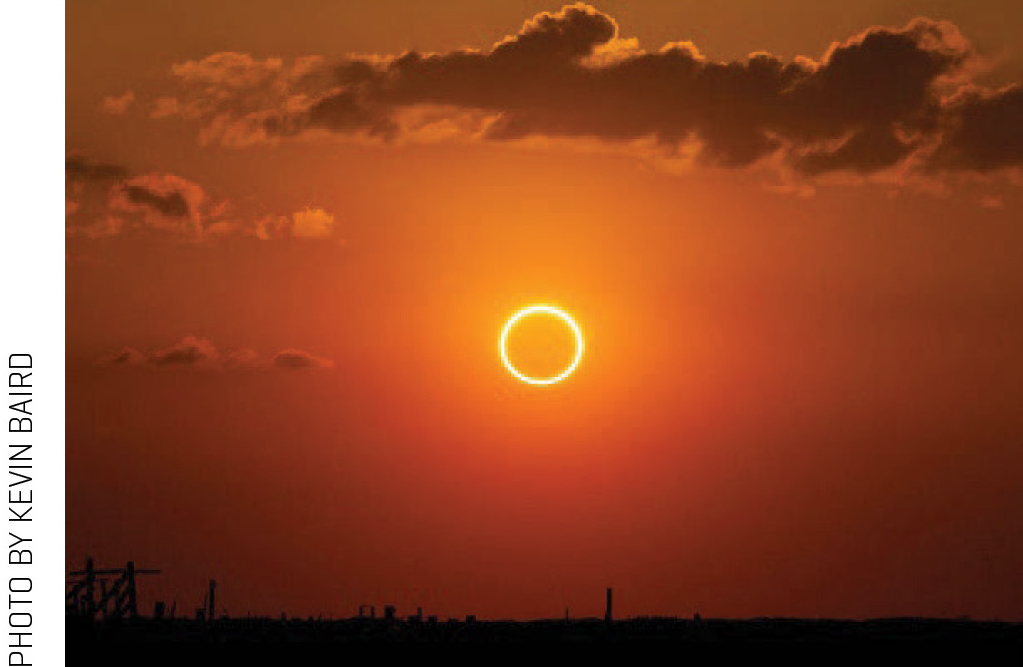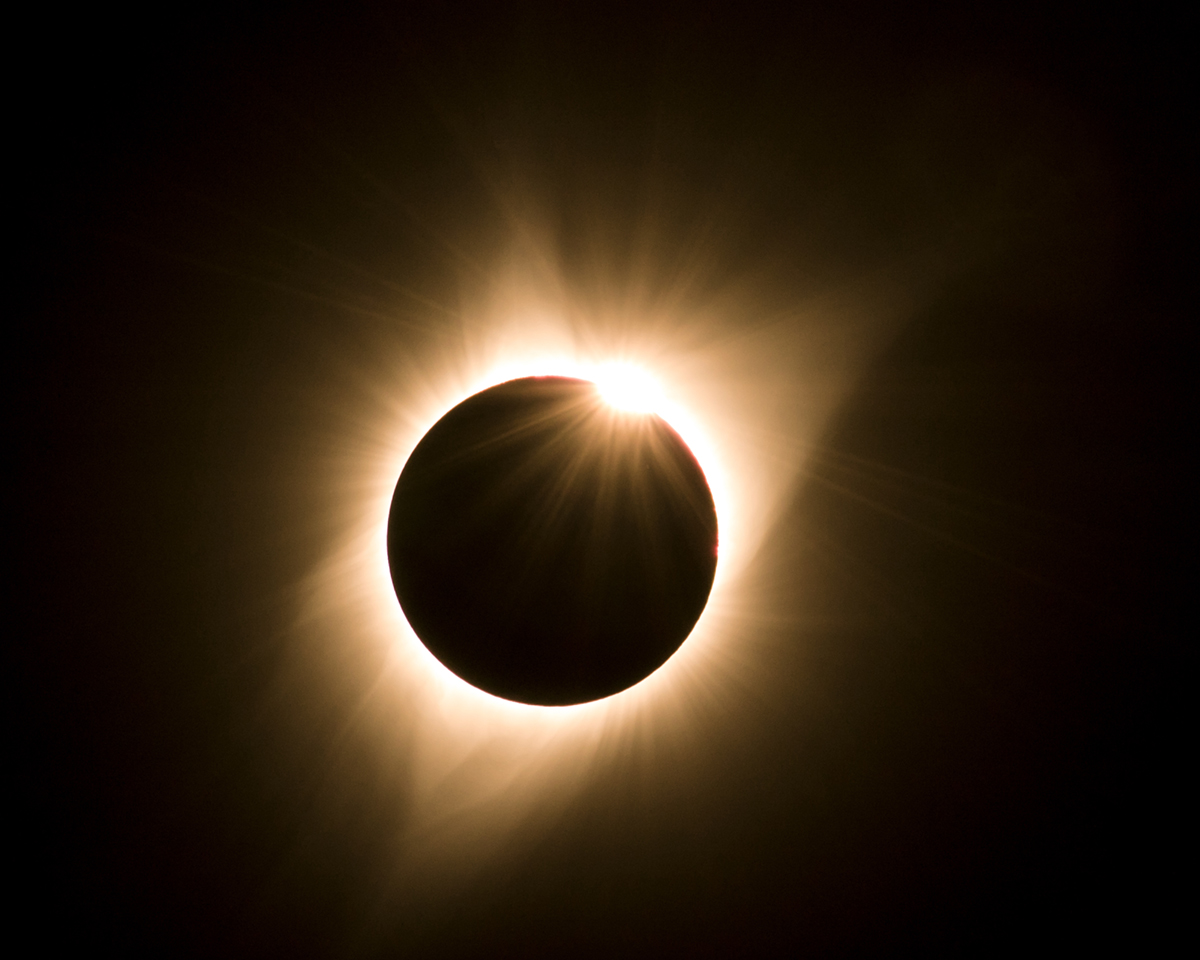feature
Making the Most of the Upcoming Solar Eclipse Double-Header October 14, 2023, and April 8, 2024
Eclipses of the Sun, where the Moon gets in front of the Sun and blocks its light, are among the most spectacular of natural events. The total eclipse visible in the United States in 2017 fascinated and involved millions of people all across the country. The good news is that against all odds, two dramatic solar eclipses—an eclipse double-header—will occur during the coming school year.
What you will see in 2023
The October 14, 2023, event is an annular eclipse, so you can think of it as the “warm-up” event for the following April. It happens on a Saturday, when school is not in session, which may actually make it more important to prepare your students to observe it safely from home.
In an annular eclipse, the Sun never goes completely dark. At maximum eclipse, you can see a dramatic “ring of fire” around the dark sphere of the Moon (Figure 1). Just as in total eclipses, you need to be in a narrow path to see the ring. If you are off that path, you see a partial eclipse, where the dark Moon appears to take a “bite” out of the Sun. Because the full Sun never goes dark during an annular eclipse, you will need to use special protective glasses or indirect viewing methods throughout the eclipse. For the United States, the annular eclipse path begins in Oregon at 9:13 a.m. PDT and ends in Texas at 12:03 p.m. CDT (Figure 2). The rest of North America (except for NW Alaska) will experience a nice partial eclipse.

Annular eclipse showing ring of solar surface (ring of fire) still visible as Moon passes in front of the Sun.
What you will see in 2024
The main event, the total solar eclipse, occurs on Monday, April 8, 2024. The path of totality (where the Sun is blocked completely by the Moon getting in front of it) is over 100 miles wide and passes over more cities than the 2017 eclipse. If you are on the path, when only a sliver of sunlight is visible, your surroundings will begin to darken, as if the Sun were setting in the middle of the day. Temperatures will drop and birds will go to roost, thinking that night is coming. Finally, the Sun will be totally covered and the beautiful solar atmosphere (the corona) will become visible (see Figures 3 and 4). Totality will last four minutes or less, and then the Sun will slowly be uncovered.

Total eclipse showing solar corona as the Moon passes in front of the Sun and completely covers the Sun’s surface.
Totality will be visible first in Mexico, coming to Texas just after noon local time. The eclipse then moves northeast through Oklahoma, Missouri, Ohio, New York, and Maine (to name just a few of the states) and into eastern Canada. Most students will be in school for the eclipse unless it happens during the week of spring break. As the eclipse moves further north and east, the times involved might come right around school dismissal in some districts, so planning ahead will be essential. Outside the narrow path of totality, all of North America will see a partial eclipse. While teachers, students, and families will want to enjoy the beauty of the solar eclipses, they will need to be prepared to safely observe the event. Remember, whenever any part of the Sun’s surface is showing, you will need to wear protective glasses or view the eclipse indirectly.
More information regarding where and when the eclipse will be visible, as well as safe viewing strategies, are in the NSTA Solar Eclipse Guide for Educators (see Online Resources).
What resources NSTA has for you
As with the 2017 eclipse, NSTA wants to be “eclipse-central” by providing all the resources you will need to make the most of the eclipse double-header. Besides the articles in this issue of Science Scope, you will want to download the NSTA Solar Eclipse Guide for Educators (see Online Resources). This guide includes most of the things you need to make your solar eclipse activities a success:
- basic information about the two eclipses and what causes them,
- how to find out specifically what you will see in your location,
- safe solar-viewing strategies,
- advice on engaging with your administrators, so they are onboard with your eclipse observing plans,
- suggestions for resource people in the community who can assist with your eclipse programming,
- links to curriculum materials to teach about eclipses, and
- informational flyers to send home to families.
How to be a resource to your community
Besides the need to prepare your students to enjoy and learn from these celestial events, there will be a demand for knowledgeable people to explain the eclipses and prepare families and other members of the community to safely view the events. Science teachers are among those who are in the best position to be of assistance by becoming “eclipse outreach agents.” Public libraries, for example, will be giving out free, safe solar-viewing glasses in many communities (thanks to a national grant from the Gordon and Betty Moore Foundation) and may appreciate help with public eclipse programs.
With the first eclipse in mid-October, the beginning of the school year provides adequate time to prepare students for understanding and observing the eclipses. Articles in this issue of Science Scope identify learning experiences to help students do that. In addition, the NSTA Eclipse Guide for Educators (see Online Resources) provides a variety of viewing techniques to safely observe the eclipses (Figure 5).
Once students feel they understand both eclipse science and solar observing safety, they can become eclipse outreach agents to others in the school, the community, and various types of media. It is best to first give them time to practice by explaining the upcoming eclipses to their families. Then, perhaps for extra credit, the most enthusiastic students can go into different classes (with handouts) to spread the news to other students. You might also work with the school library and principal’s office to organize a schoolwide assembly and/or to set up exhibits or bulletin boards to provide eclipse information for everyone in the school.
If there is an amateur astronomy club in your community, their members may be willing to come out to your location to work with the science teachers and youth/families in the days leading up to each eclipse. A list of astronomy clubs in the United States that are especially interested in doing school and public outreach can be found through NASA and the Astronomical Society of the Pacific’s Night Sky Network (see Online Resources). Other resource people who can be helpful are listed in the NSTA Solar Eclipse Guide for Educators (see Online Resources).
Don’t forget to get the school’s PSTA involved early when thinking about eclipse programs. Companies that manufacture safe eclipse viewing glasses (see Online Resources) offer substantial discounts for bulk orders in advance. The PSTA could either fund eclipse glasses for the whole school or buy glasses in bulk and then sell them (at reasonable prices) to families and neighbors, making the project a fundraiser for the school (Figure 6).
As news about the upcoming eclipses gets out to people, there will be growing public interest in finding information, eclipse glasses, and other safe-viewing methods. As we saw earlier, public libraries are likely to be centers for community eclipse information, particularly in towns that do not have easy access to college astronomy departments or science museums.
The Solar Eclipse Activities for Libraries (SEAL) Project at the Space Science Institute in Boulder, CO has funding from the Moore Foundation to provide 10,000 libraries with five million solar-viewing glasses and information regarding the upcoming eclipses. Libraries that join the network are encouraged to find partners, including local science teachers, to help do community eclipse events. For more on the network and a list of libraries involved, go to the SEAL website (see Online Resources). You can see if your local library is participating. If so, you and your students could volunteer to help. If the library is not part of STAR Net, encourage the library to join the network and offer ways you might be available to help when they are ready to provide eclipse programs for the community. If your community has a college or university with an astronomy department or a science museum that does astronomy programs, they may already be making plans for public or community events, and may be delighted if you and some student volunteers want to help them.
Television, radio, and newspapers will likely be the last to “tune in” to the eclipses, so most reporters are likely to find out about the eclipse pretty late from their national sources. You might want to approach a local media outlet and give them an early heads-up about the eclipse. Just be sure you include enough background information so that a nonscience person can understand what will be happening during the coming year. They might even decide to come out to your school or the local library when eclipse events are happening and make it a special occasion for everyone. You and your students might also develop some educational posts for social media, including some of the free eclipse images (see Online Resources).
Science teachers are among those who are in the best position to be of assistance by becoming “eclipse outreach agents.”
Please remember that the day of the eclipse will be too late for most information programs, training sessions, and selling or providing glasses to families scattered around your community. It is in the months and weeks leading up to the eclipse that outreach activities are most needed.
We know that people learn the most about something they teach to others, so this is the perfect time to practice this strategy. We hope you and your students find plenty of opportunities to educate and inform others in your school and community. Most important, we hope you enjoy clear skies and safe eclipse viewing on October 14, 2023, and then again on April 8, 2024.
ONLINE RESOURCES
NSTA Solar Eclipse Guide for Educators—https://bit.ly/3NZIRpS
NSTA book of Moon, Sun, and eclipse activities—https://bit.ly/3LVTF5M
NSTA children’s book about eclipses—https://my.nsta.org/resource/108257
NSTA web seminar on the eclipse (featuring this article’s authors)—https://bit.ly/3IhnDjL
Free Moon, Sun, and eclipse activities on the web—https://bit.ly/41GLJej
Times and circumstances of any eclipse in your community—https://www.timeanddate.com/eclipse/
American Astronomical Society authoritative webpage on safe eclipse viewing— https://eclipse.aas.org/eye-safety
American Paper Optics (manufacturer of safe eclipse viewing glasses)—http://www.eclipseglasses.com
Rainbow Symphony (manufacturer of safe eclipse viewing glasses)—https://bit.ly/3HZlusE
NASA Eclipse website—https://go.nasa.gov/3nY6Bjp
The Great American Eclipse website (with good maps)—http://www.greatamericaneclipse.com
Space Science Institute Solar Eclipse Activities for Libraries (SEAL) Project—https://bit.ly/3VYviZW
Exploratorium Science Museum links to live telecast of the eclipses (plus nice videos and activities for understanding and viewing eclipses)—https://www.exploratorium.edu/eclipse
Best weather predictions for eclipse days—https://eclipsophile.com
Resources connecting eclipses and fiction/films/music, etc.—https://bit.ly/3MwpMKF
List of astronomy clubs in the U.S.—https://nightsky.jpl.nasa.gov/
Free eclipse images—https://eclipse.aas.org/resources/images-videos
Andrew Fraknoi (fraknoi@fhda.edu) is Professor of Astronomy at the Fromm Institute at the University of San Francisco. Dennis Schatz (schatz@pacsci.org) is Senior Fellow at the Institute for Learning Innovation. He lives in Seattle, Washington. They are both leaders in the Solar Eclipse Task Force of the American Astronomical Society and in the project to distribute 5 million safe-viewing glasses (and information) for the upcoming eclipses through 10,000 public libraries, funded by the Gordon and Betty Moore Foundation.
Astronomy Earth & Space Science Phenomena Middle School






